Celtic - Jewellery - Northern Europe - Photo gallery
Image database with photographs of ancient art and antiquities
Our image database provides photographs of ancient art and antiquities for press releases as well as for private use. All artefacts sold in our gallery are documented through professional photographs. The resulting image library contains numerous ancient Egyptian, Greek and Roman antiquities as well as ancient coins. The time span from Stone Age, over Bronze Age and Classical Antiquity until Late Antiquity is covered.The photo gallery aims at providing a vast visual archive equipped with filters and search tools. You are most welcome to search the constantly growing number of artefacts in the image library. We are also happy to authorize hyperlinks from your webpage / forum to the objects depicted in our gallery. For this purpose, please send us a short notification prior to placing a hyperlink. For almost every object high definition photographs are available and can be provided e.g. to document your collection or for scientific papers or popular science articles. If you are interested in using pictures for publications, print media or other purposes, please contact us and we will be happy to assist you.
-
 Roman discus fibula with color glass paste
Roman discus fibula with color glass pasteSpannende Fibel mit Sterndekor und Glaspaste. Eine Weiterentwicklung keltischen Kunsthandwerks in der Zeit römischer Herrschaft. Gut dokumentierter Typ aus dem 2. Jh. v. Chr. mit Verbreitung in weiten Teilen Europas.
Price: on request Gallo-Roman animal fibula
Gallo-Roman animal fibulaZoomorphe Fibel mit Wildtier als Motiv. Schmuckstück mit religiöser Symbolik, vergleichbar einem Kreuzanhänger bei heutigen Christen. Gefertigt im 1. bis 3. Jh. n. Chr. in Gallien.
Price: on request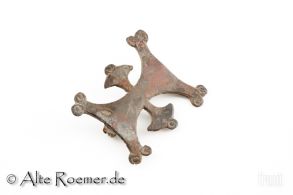 Rare discus-shaped Celtic-Roman fibula
Rare discus-shaped Celtic-Roman fibulaAus der Entstehungszeit der plattenförmigen Fibeln, 1. Jh. n. Chr. Ästhetisch ansprechende Metallarbeit aus einer Fusion keltischer Handwerkstraditionen mit römischen Vorlieben.
Price: on request Enameled Galo-Roman fibula
Enameled Galo-Roman fibulaGrundform einer rechteckigen Platte, erweitert durch Zierknopf an Kopf- und Fußende. Drei Paare von Dreiecken auf der Platte sind durch weiße Einlagen hervorgehoben. Etwa 2. Jh. n. Chr.
Price: on request Impressively preserved enameled Roman brooch
Impressively preserved enameled Roman broochIn Britannien und Gallien produzierter Fibeltyp des zweiten Jahrhunderts. Edel patinierte Bronzeoberfläche. Besonders hervorzuheben ist die Emailauflage in selten gutem Erhaltungszustand.
Price: on request Römischer Ring aus Silber
Römischer Ring aus SilberRömische Kaiserzeit, möglicherweise aus der keltischen Provinz oder Provinznähe. Ringband geht nahtlos in die Ringplatte über. Theoretisch auch heute noch als Amulett oder Fingerring tragbar. Innendurchmesser 17mm bis 18mm.
Price: on request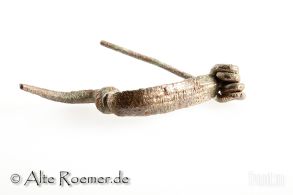 Keltische Fibel der Latènezeit
Keltische Fibel der LatènezeitAntike Gewandnadel aus Bronze. Variante der Jezerine-Typ-Fibeln, vermutlich aus Süddeutschland, 1. Jh. v. Chr.
Price: on request Eisenzeitliche, europäische Fibel
Eisenzeitliche, europäische FibelHervorragend erhaltene, keltische Bronzefibel aus der Eisenzeit, 6. bis 3. Jh. v. Chr. Früher Fibeltyp in schöner Erhaltung.
Price: on request Frühe, europäische Fibel
Frühe, europäische FibelHervorragend erhaltene, keltische Bronzefibel aus der Eisenzeit, 6. bis 3. Jh. v. Chr. Großartiges Beispiel für einen der frühesten Fibeltypen.
Price: on request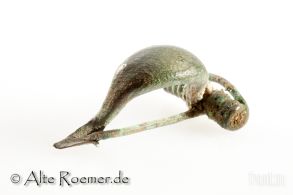 Frühe, europäische Fibel
Frühe, europäische FibelVollständig erhaltene, keltische Bronzefibel aus der Eisenzeit, 6. bis 3. Jh. v. Chr. Großartiges Beispiel für einen der frühesten Fibeltypen.
Price: on request Früher Fibeltyp mit Zierplatte
Früher Fibeltyp mit ZierplatteAntike Fibel mit emaillierter Zierplatte. Schön patinierter Bronzekörper mit reichem Dekor. 2. Jh. v. Chr. bis 1. Jh. n. Chr.
Price: on request römisches Amulett in Form eines Beilkopfs
römisches Amulett in Form eines BeilkopfsAmulette dieser Art sind bereits aus dem 4. - 2. Jh. v. Chr. bei keltischen Stämmen belegt. In dieser Erhaltung selten.
Price: on request keltische - römische Gewandnadel oder Haarnadel aus Bronze
keltische - römische Gewandnadel oder Haarnadel aus BronzeSehr gut erhalten, leicht verbogen. Schöne Patina, kunstvoll gearbeitet.
Price: on request Keltische Fibel aus der La Tene II-Zeit
Keltische Fibel aus der La Tene II-ZeitBronzefibel des 2. bis 1. Jh. v. Chr. Mit ihrer eleganten, einfachen Ausführung ein Musterbeispiel einer La Tene-Zeit-Fibel in museumswürdiger Erhaltung.
Price: on request Keltische Fibel mit P-förmigem Profil
Keltische Fibel mit P-förmigem ProfilKeltische Fibel, Variante aus der La Tène-Zeit. Interessanter, massiver Typ aus dem 3. bis 1. Jh. v. Chr. 63mm lang, 25g.
Price: on request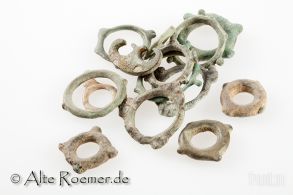 Protogeld in Ringform, diverse Ausprägungen
Protogeld in Ringform, diverse Ausprägungen13 Ringgeldexemplare und ein Pelta-Amulett. Exzellent erhalten, mit schöner Fundpatina. In dieser Formenvielfalt selten angeboten.
Price: on request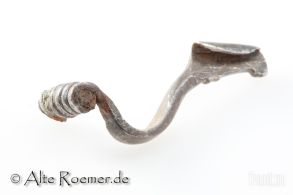 Keltische Fibel aus Silber
Keltische Fibel aus SilberSeltener Typ mit Dekor, 1. Jh. v. Chr. - 1. Jh. n. Chr. Museales Stück mit schöner Tönung.
Price: on request Römische Nadel aus Bein
Römische Nadel aus BeinNadel oder Haarnadel aus Bein. Kunstvoll gearbeiteter Kopf. Fundort: White Noteley, Essex, England.
Price: on request Römische Silberfibel
Römische SilberfibelMassive Fibel aus Silber. Fundort England, aus alter britischer Sammlung. Museumswürdiges Exemplar.
Price: on request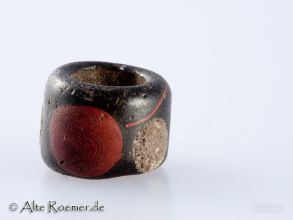 Keltische Glasperle
Keltische GlasperlePerle aus dunklem Glas mit wunderschön gemaserter roter Verzierung, ca. 200 v. Chr., Fund aus Posen, Polen.
Price: on request
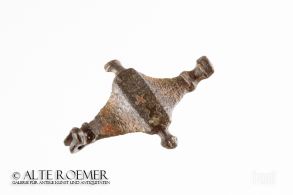 Published Roman fibula with celtic design
Published Roman fibula with celtic designAncient fibula from the Roman province of Britain. The design can be attributed to the celtic tribe of the Trinovantes or Iceni. From the famous Hattatt collection. Published twice.
Price: on request Ancient fibula from the Hattatt collection
Ancient fibula from the Hattatt collectionAncient fibula of the rare adlocutio type. Repoussé work of a scene from a Roman sestertius of Hadrian in celtic style. Find from Dorset in Roman Britain. Published in Hattatts famous book series on ancient fibulae.
Price: on request Celtic fibula from the famous Hattatt collection
Celtic fibula from the famous Hattatt collectionFibula from the La Tène II period. Found in Celtic Carnuntum. The piece is published in the standard work "Iron Age and Roman Brooches".
Price: on request Elaborate Roman plate brooch
Elaborate Roman plate broochTen pointed star form with leaf pattern and decorative buttons. A product of Gaul or Britain dating to the 1st century.
Price: on request Roman plate brooch with colourful enamel
Roman plate brooch with colourful enamelRare fibula type from Roman Britain. The fully intact multicoloured enamel makes this piece worthy of being a museum exhibit. 2nd cent. AD.
Price: on request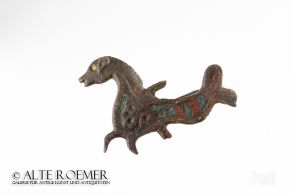 Ancient brooch of a fabulous creature
Ancient brooch of a fabulous creatureRare Hippocampus brooch with elaborate inlays of multi-coloured glass paste and metal. Great example of the brooch manufacturing of Roman Gaul during the mid 1st cent. AD.
Price: on request Celtic fibula
Celtic fibulaRare fibula from the La Tène culture with beautiful enamel inlays. The main material is well preserved for an iron fibula.
Price: on request Celtic bracelet of the La Tène culture
Celtic bracelet of the La Tène cultureImpressive and solid bronze jewellery from the Early La Tène period, 450 to 250 BC. Found in Southern Germany.
Price: on request Celtic neck ring
Celtic neck ringOpen ring made of solid bronze. The torc is from Gaul or Central Europe and dates to the 4th or 3rd century BC.
Price: on request Celtic penannular brooch
Celtic penannular broochPossibly made by the Celtic Durotriges tribe under Roman rule in Britain. The piece is published in two books by Richard Hattatt.
Price: on request Dolphin brooch from Roman Britain
Dolphin brooch from Roman BritainThe so-called dolphin brooch is very British. This specimen was probably made by the Celtic Corieltauvi tribe, shortly after the arrival of the Romans in the middle of the 1st century. Published in two works by Richard Hattatt.
Price: on request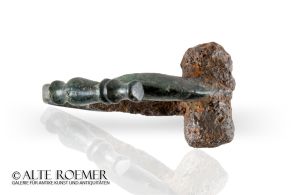 Celtic brooch from Iberia
Celtic brooch from IberiaThe early Celtic brooch dates from the 6th century BC and was found in Spain. This specimen is published in two standard works on ancient brooches.
Price: on request Disc brooch from Roman Britain
Disc brooch from Roman BritainNicely enameled brooch with a Romano-Celtic sunburst design. From the 2nd century AD. Published in two stardard works on ancient brooches by Richard Hattatt.
Price: on request Trumpet brooch with Celtic decorations
Trumpet brooch with Celtic decorationsUnusual and rare variant of high importance, published several times. Beautiful silver inlays on the bow showing tendrils in Celtic style. From the 1st century.
Price: on request Disc brooch from Roman Britain
Disc brooch from Roman BritainBrooch with a Romano-Celtic sunburst design. Circa 2nd century. A find from Roman Britain

